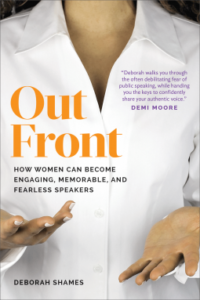WOW. I am confident that I have broken a few of her suggestions by writing such a long review. There were so many great takeaways from this book that I want to share with you. I highlighted even more than this on my ebook version. In summary, if you are a female speaker, I HIGHLY RECOMMEND that you read this book. She has so many practical tips that you can start implementing immediately. I am excited about my next presentation to see how many of these I can implement.
 Deborah formed a company called Eloqui to train and coach people to be effective presenters. In this book the author discusses the challenges that women face and she provides steps on how to overcome them.
Deborah formed a company called Eloqui to train and coach people to be effective presenters. In this book the author discusses the challenges that women face and she provides steps on how to overcome them.
- You’re seen as a go to person in your industry when you address an audience even if you’re not paid.
- Your fear of failure can become a self-fulfilling prophecy so it’s important to overcome it.
- Great speakers are not just born. Becoming an engaging speaker requires skill, courage and commitment to your audience.
- She recommends incorporating your own personality into your presentation. It’s very important to be authentic. When a speaker reveals something meaningful about themselves the audience considers them more likable. Audiences trust and respond to speakers who provide a window into that thinking even when they don’t agree with you.
- Great presenters are masters of emotional persuasion and connecting with the audience. It’s much more powerful and effective to persuade an audience than to try to convince them you’re an expert. Your focus should be on the audience.
There are 6 sections. You need to understand intention and which role to play as you present. How to manage anxiety, storytelling, how to move while you’re presenting, and how to create a group in narrative.
She also mentioned that research reveals when it comes to leadership skills men are more confident, and women are more competent. It’s interesting that I just read this in a very similar book within the last month.
She recommends listening to the top 10 list of female Ted speakers; two of her favorites or Dr. Jill Bolte Taylor and Brene Brown. I’ve made myself a note to look at both of these.
How you walk onto the stage is very telling of how the audience will react to you. Strong speakers will exude confidence purpose and have energy in their stride
 She shares 10 speaking myths. I will cover a few of them that were impactful to me.
She shares 10 speaking myths. I will cover a few of them that were impactful to me.
#1 – You’re born a great public speaker. I think most of us feel that people innately have a better personality to speak. She says becoming a great presenter takes commitment, accepting feedback and incorporating the lessons learned. She share stories where she has seen vast improvement in only a few sessions working with people. It’s important to take risk to become a better presenter. She encourages us to talk without a PowerPoint. Especially during your opening and closing when you want the focus to be on you and not the PowerPoint.
#3 – It’s unprofessional to include my values experience or perspective when presenting a business topic. She encourages us to share why something is important to us. This helps the audience to connect with us and understand why it’s important to us. There are two important factors for a speaker to have a high likability score. One is that they reveal something personal about themselves in the opening remarks and that their presentation is tailored to the audience.
#5 – Women are more effective behind the scenes. It’s important to be authentic and invested in your material. She gives specific instructions on how to include movement on the stage to connect with your audience. It’s very important to come across as connected to both your topic and the audience. You can do this by asking questions, by specific movement based how and where you are on the stage.
#8 – Audiences would judge me harshly. She gives us techniques for when we stumble in a presentation. One of them is to recap what you’ve presented even if you are only a few minutes into your presentation. You could also take a few steps in any direction and look thoughtful as you’re trying to remember what you want to say next. It’s also helpful to find the fun friendly faces in the audience.
#10 – I can play it safe and still achieve my goals. If we don’t take risks to differentiate ourselves, we will remain indistinguishable from our competition
Dress the part. She recommends to always look professional and to wear clothing that is consistent with your clients dress code. She recommends selecting an outfit that you look good and makes you feel good. I also read recently that you should wear something that’s not going to be out of style if you’re recording the section to be on a website. It’s important to sound natural as some of us will switch into a presentation tone of voice, It’s important to sound conversational as we’re presenting. The conversational tone is more persuasive. Women also have a habit of saying filler words that are unprofessional. She also share some tells. For example, sticking her hands in her pocket, crossing her arms, fiddling with her hair or clothing and crossing her legs as werre standing.

Women have strength at telling stories and she recommends doing that in your presentation. Just ensure that the story is related to your presentation. Authenticity is essential for creating credibility. When presenting is more important to be conversational than to speak perfectly and grammatically.
Storytelling. People want to be immersed in your story. Stories are more effective than arguments and facts. It changes people’s minds and persuades them. It can be difficult to change how we see the world and process information but we can adapt to someone else’s communication style. As a side note, I’m a huge fan of the disc personality profile which helps you identify others style and adapt to their style to increase communication.
She shares with us some different roles and styles. For example, a collaborator you would want to convince them to buy into your idea but appealing to their heart more than their intellect. For an analyzer it was just the opposite; they are going to want more facts. Stories can be at the beginning middle or end of your presentation. Identify one strong message in your story to ensure you’re not just rambling. There are three acts of a great story. The obstacle is where you hook the audience. The solution is where you describe your specific process and what set you apart. And then the benefits or the outcome is what everyone wants to know. We need to realize the value of our stories and start using them to showcase our strengths and to demonstrate what sets us apart. It’s important to determine what you want to achieve which is similar to the intention we talked about earlier.
One of the key points that I hope to implement immediately was to grab the attention of your audience with an exciting opening. The opening sets the tone and the frame for the presentation. Good openings often suggest a theme that you can repeat throughout the presentation.
It is important to only have three bullets in any section. People have a tough time remembering more than three items. Determine how you will transition between sections.
There are three ways to conclude your presentation. One is a call to action using 3 active verbs, a bookend where are you re-visit your opening with one new insight, or a recap where you summarize your key points.
The first thing you should do is understand your “intention”. Intention is powerful and it forces us to focus and make decisions when editing our content. Intention is one the most difficult concepts because there is so much we want to share. You should only have one intention per presentation. You should only choose content that supports that intention. In the presentation, we often try to accomplish too much which does not help us. Focus all of your content back to the intention. Having a solid clear intention will make you fearless. We all know a lot about our topic but the audience doesn’t need to know or care about everything. They only need to know what’s important that supports your intention.
She mentions it in her years of observing leaders the one consistent quality was that they conducted their business intentionally.
Roles we can play while speaking. There’s a mobilizer, visionary, facilitator, motivator, and seasoned veteran. If your presentation is to share the big picture then be the season veteran motivator, visionary, or immobilizer. If your responsibility is to handle the process and the details then choose the role of facilitator, liaison, or coach.
The audience gets to know you in the opening and they remember you from the closing. The opening sets the hook, creates the frame and establishes a connection between you and the audience. You only have a brief window of time that the audience gives you the luxury of their full attention. Make sure you take advantage of it. This is something I am working on for my next presentation. We all fall into the habit of thanking the person who introduced us, stating our name and a little about ourselves. This can be very boring when they have heard several speakers present.
Once you’ve delivered your colorful opening make sure you have an intelligent link to your topic. When you capture the audience’s attention with your opening that will give you energy that will propel you through the rest of the presentation. When you close, use short phrases and sentences, pause between each one, and remember to only use three if you’re going to give them a list or call to action. Slow down and be a bit dramatic with your closing remarks. She recommends paying as much attention on your delivery as you do your content.
For your opening and close don’t move; instead stand in the center of the space and make a connection with your audience. It’s okay to move your hands and be flexible from the waist up but remain in one spot.
When you’re working on your PowerPoint deck there should only be one key takeaway per slide. This process will let you know when you have too much content on one side. She recommended Logitech Wireless Presenter R400 for a high-quality remote for changing the PowerPoint slides. She said it is small so the audience doesn’t see it and it will help you look natural while you’re on stage. It also has a button that will make the screen go black so that the focus is on you and not the PowerPoint when you want the audience’s attention. Then you can click the button to bring the presentation back up.
Another new suggestion to me was creating a presenters deck and a leave behind deck. The leave behind deck has a lot more content. She recommends creating the leave behind first and then deleting all the info that you don’t need for the presentation deck.
There’s a whole section on how to prepare for the event making sure you check out the technology beforehand and try to practice in the location where you’ll be presenting. She gives tips for when you’re presenting using software program like Skype, etc. Something I found interesting was to wear solid colors and to default to something blue which looks the best on camera.
She also has a section on 10 tips for better communication. Some of them are very similar to presenting.
She believes what keeps executives from achieving greatness is playing it safe. For women I think this is even harder because we’re risk-averse. Go out there and challenge yourself to take a risk
In the appendix there is a trusted advisor template.

